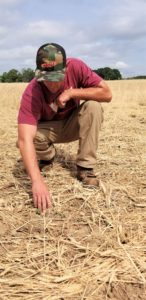
John Shepherd began grain farming during his last year of college working as a salesman by day and farming at night.
By: Herbert Brown, FSA
John Shepherd, a farmer from Blackstone, Virginia, began grain farming during his last year of college. After graduating, he worked as a salesman by day and farmed at night, building his operation from the ground up.
Top Priorities
In the grain fields of Blackstone, John sprays his corn fields and plants soybeans like many other farmers in the area. He scans the rows, looking for recently-planted soybeans as they begin to emerge from his tall wheat cover crop.
“This cover crop was planted by airplane,” he said. “It allows earlier planting in the fall and creates a good stand of small grains.”
Cover crops, nutrient management, and soil productivity are all top priorities for him.
“I’m attached to the land. It’s taken me years and a lot of inputs to get the land in good shape. I take pride in what I do,” John said.
Building the Farm with FSA
During his farming career, John has expanded his farm from a 25-acre operation to over 2,600 acres. Farm loan programs from USDA’s Farm Service Agency helped grow his operation. He originally started with an operating loan to help cover the costs of running his farm. In 2012, John applied for a farm ownership loan to purchase additional farmland and grow his operation.
“I couldn’t have done any of this without FSA,” he said. “I have had nothing but extremely positive and great experiences with the FSA county staff.”
He now farms in multiple counties and has obtained two Farm Storage Facility Loans to house his growing harvest. To prepare for potential market downturns, he also enrolled his eligible crops in the Agriculture Risk Coverage and Price Loss Coverage program, which can provide a crucial safety-net. These loans and programs from FSA have been crucial in helping expand his farm and ensure its future.

John has expanded his farm from a 25-acre operation to over 2,600 acres.
Healthy Soil
He started farming on fields that had poorly performed in the past and turned them into highly productive assets.
Over the years, he transformed and improved his soils with a combination of the concepts he learned in college and help from USDA’s Natural Resources Conservation Service.
NRCS programs like the Environmental Quality Incentives Program and the Conservation Stewardship Program help John manage his land with a variety of conservation practices. These practices include tillage management, crop rotation, nutrient management and more.
John credits his soils classes and professors for giving him the in-depth knowledge he needed to increase his yields.
“All resources are key but knowing the right person to call means a lot,” he said. “I rely on the experts to get the best information.”
More Information
USDA offers a variety of risk management, disaster assistance, loan, and conservation programs to help agricultural producers in the United States weather ups and downs in the market and recover from natural disasters as well as invest in improvements to their operations. Learn about additional programs.
For more information about USDA programs and services, contact your local USDA service center.
For the digital version of this blog, visit #FridaysOnTheFarm.





